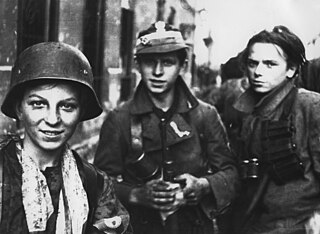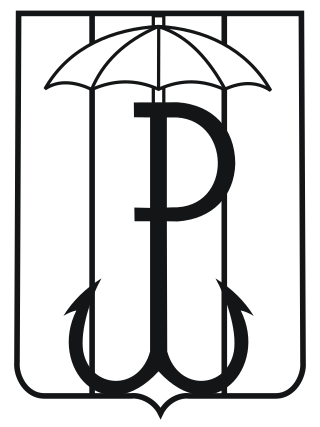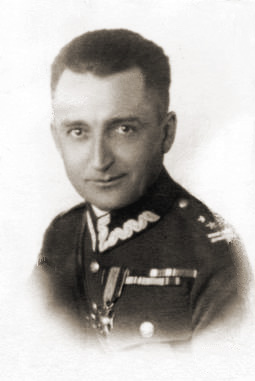
A submachine gun (SMG) is a magazine-fed automatic carbine designed to fire handgun cartridges. The term "submachine gun" was coined by John T. Thompson, the inventor of the Thompson submachine gun, to describe its design concept as an automatic firearm with notably less firepower than a machine gun. As a machine gun must fire rifle cartridges to be classified as such, submachine guns are not considered machine guns.

Reinhard Heydrich, the commander of the German Reich Security Main Office (RSHA), the acting governor of the Protectorate of Bohemia and Moravia and a principal architect of the Holocaust, was assassinated during the Second World War in a coordinated operation by the Czechoslovak resistance. The assassination attempt, code-named Operation Anthropoid, was carried out by resistance operatives Jozef Gabčík and Jan Kubiš on 27 May 1942. Heydrich was wounded in the attack and died of his wounds on 4 June 1942.

The Warsaw Ghetto Uprising was the 1943 act of Jewish resistance in the Warsaw Ghetto in German-occupied Poland during World War II to oppose Nazi Germany's final effort to transport the remaining ghetto population to the gas chambers of the Majdanek and Treblinka extermination camps.

Kedyw (Polish pronunciation: [ˈkɛdɨf], partial acronym of Kierownictwo Dywersji was a Polish World War II Home Army unit that conducted active and passive sabotage, propaganda and armed operations against Nazi German forces and collaborators.

"Grey Ranks" was a codename for the underground paramilitary Polish Scouting Association during World War II.

Bechowiec was a Polish World War II submachine gun developed and produced by the underground Bataliony Chłopskie resistance organisation. It was designed in 1943 by Henryk Strąpoć and was produced in underground facilities in the area of Ostrowiec Świętokrzyski. Its name was coined after the Bataliony Chłopskie organization members who were informally called bechowiec.

The Błyskawica was a submachine gun produced by the Armia Krajowa, or Home Army, a Polish resistance movement fighting the Germans in occupied Poland. Together with a Polish version of the Sten sub-machine gun, with which it shares some design elements, it was the only weapon mass-produced covertly in occupied Europe during World War II.

Battalion Parasol was a Scouting battalion of the Armia Krajowa, the primary Polish resistance movement in World War II. It consisted primarily of members of the Gray Ranks. The battalion distinguished itself in numerous underground operations and took part in the Warsaw Uprising of 1944, as an element of the Radosław Group.

Franz Kutschera was an Austrian Nazi politician and government official. He held numerous administrative offices with the Nazi Party and the Schutzstaffel (SS) both before and after the Anschluss of Austria in 1938. During World War II, he served with the SS in France, Yugoslavia, the Soviet Union, and finally Poland.

The Polish resistance movement in World War II, with the Polish Home Army at its forefront covered both German and Soviet zones of occupation. The Polish resistance is notable among others for disrupting German supply lines to the Eastern Front, and providing intelligence reports to the British intelligence agencies. It was a part of the Polish Underground State.

August Emil Fieldorf was a Polish brigadier general who served as deputy commander-in-chief of the Home Army after the suppression of the Warsaw Uprising.
Operation Wieniec was a large-scale World War II anti-Nazi Home Army operation. It took place on the night of 7 to 8 October 1942, targeting rail infrastructure near Warsaw. Similar operations, aimed at disrupting German transport and communications in occupied Poland, occurred in subsequent months and years, targeting railroads, bridges and supply depots, primarily near transport hubs such as Warsaw and Lublin.
Operation Bürkl, or the special combat action Bürkl, was an operation by the Polish resistance conducted on 7 September 1943. It was the second action of Operation Heads, a series of assassinations of notorious SS officers in Warsaw carried out by the Kedyw's special group Agat ("Anti-Gestapo") between 1943 and 1944, and their first success.
Operation Heads was the code name for a series of assassinations of Nazi officials by the World War II Polish Resistance. Those targeted for assassination had been sentenced to death by Polish Underground Special Courts for crimes against Polish citizens during the World War II German occupation of Poland. The operation's code name, literally "Operation Little Heads", was a sardonic reference to the Totenkopf insignia on Nazi German SS uniforms and headgear.

Kazimierz Piechowski was a Polish engineer, Boy Scout during the Second Polish Republic, and political prisoner of the Nazis held at Auschwitz concentration camp. He was a soldier of the Polish Home Army, and again became a political prisoner under the post-war communist government of Poland for seven years.

Action Ghetto was the code name for the armed actions of the Polish Underground State during the Warsaw Ghetto Uprising aimed at helping the insurgents. The name was given to a series of combat actions carried out by the Home Army during the uprising between 19 April 1943 and May 16, 1943.
Akcja Fruhwirth - assassination attempt carried out on October 25, 1943 at SS-Scharführer Engelberth Frühwirth, which was part of an extensive campaign to eliminate representatives of the Nazi German terror apparatus in occupied Poland called Operation Heads.















